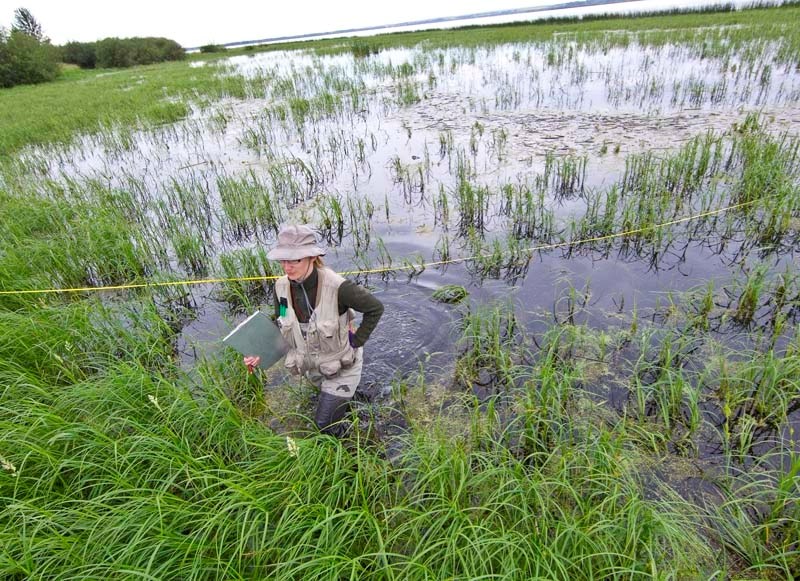Lois Hole Park contains a plant so rare that it’s found in just five places in Alberta, a new study reveals.
The Big Lake Environment Support Society (BLESS) released a vegetation and rare plant survey of Lois Hole Centennial Provincial Park this week. The study, done earlier this year, is the first comprehensive catalogue of plant life in the provincial park.
BLESS is the official steward of Big Lake, said Miles Constable, one of the study’s co-ordinators, and had previously done a bird survey of the region. “How do you protect something when you don’t know what was there?” Concerned about future development around Lois Hole Park, the group commissioned this study to create a baseline of conditions in the park.
Biologist and study author Melanie Patchell spent last summer slogging through the park to catalogue some 274 different species of plant. “I spent a lot of time in hip-waders,” she said. She also established 24 permanent monitoring plots residents can use to track biological changes in the park.
Plants present include the towering balsam poplar, the invasive Kentucky bluegrass, the ubiquitous duck weed and the common bladderwort – a carnivorous aquatic plant that devours invertebrates foolish enough to swim into its bladder-traps.
Patchell also found 21 plants in the park that are rare in Alberta, including the river bulrush – a plant found at fewer than five locations in the province.
“It’s a big, distinctive looking sedge,” Patchell said of the plant, one found in only a few remote spots in the park in metre-deep water. You’re unlikely to spot it unless you’re in a boat, but it has distinctive triangular stems and long, one- to three-centimetre spikelets for flowers.
The river bulrush is not endangered, Patchell noted, being relatively common south of Alberta, but this population could be harmed by careless feet or boardwalk construction.
Future development around Big Lake could affect water levels and plant populations in the park, Patchell noted. Locals should also watch for invasive plants like the flowering rush that could flow into the park from upstream – the park was already home to dense stands of Canada thistle.
It’s neat to see that this park preserves so many kinds of plant and wildlife, Patchell said. “We can coexist with them as long as we respect their space.”
BLESS now plans to use information from the study and an Environmental Initiatives Grant to make an illustrated plant guide to the park, Constable said. Copies of Patchell’s study would be sent to local libraries, governments, and the Edmonton Community Foundation (which backed the $20,000 study).
The study will soon be posted at bless.ab.ca.
Riverlot 56 fans should keep an eye out for lawbreakers this winter after some snowmobilers vandalized the park’s fence and ski trails.
Members of the St. Albert Nordic Ski Club (STANSKI) discovered the damage earlier this month.
STANSKI member Ken Ryniak said he believed it happened sometime on the night of Dec. 6 just after he had set trails through the natural area. When he returned to the park on the 7th, he found that someone had cut the wire fence around the park and driven one or more snowmobiles into it.
“They cut the wire and went in and toured the inside trails,” he said. The place where they cut the wire was close to a prominent “no ski-doos” sign, he noted – indeed, the whole area was littered with them.
Sturgeon County Bylaw 1047-04 bans snowmobiles and ATVs from Riverlot 56. Anyone caught using one there can be fined $150.
It’s the first time this has happened in years, Ryniak said. “It’s extremely frustrating.” It takes two people three hours a week to set trails in the park, and they had to redo all of them because of these snowmobilers. The fence also had to be repaired.
This was a clear case of vandalism, said Riverlot 56 Natural Area Society board member Dan Stoker. “Someone was out to make a mess.”
This was a natural area, Stoker said, and the noise from snowmobiles was likely to stress local wildlife. “The less traffic of that kind we have in there, the better.”
It’s also dangerous to people and animals to have snowmobiles blasting through the region, Ryniak said.
STANSKI and county officials are the only groups allowed to have motorized vehicles in Riverlot 56, Ryniak said. He asked people who see anyone else with a vehicle in the park to take a picture of the vehicle’s licence plate and contact the RCMP.




